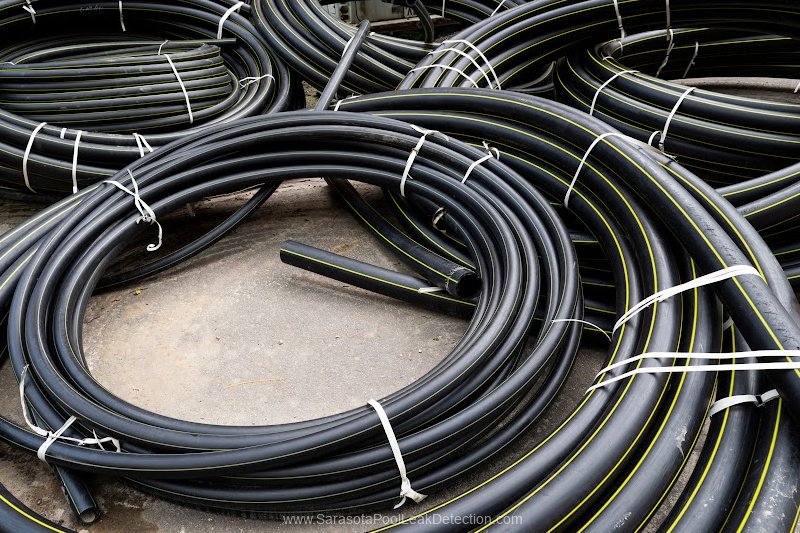One of the perks of owning a pool in Florida is that you can enjoy outdoor pool weather practically year-round. Since most Sarasota pool owners love taking a dip throughout the year, you can only imagine the extent of wear and tear on pool equipment and plumbing.
To ensure that your swimming pool is energy efficient, pool plumbing should be designed and installed correctly. Correct installation of pipes and fixtures also entails burying the pipes at an appropriate depth.

The standard depth for burying pool pipes is 2 feet. Plumbing lines 2 feet underground aren’t susceptible to damage due to freezing temperatures or soil slip and shift.
However, in Southern states with warmer climates like Florida, pool lines can be installed at a shallower depth.
While it’s good practice to keep the standard plumbing line depth at 2 feet, burying pipes at a shallower depth will make repairing pipe leaks easier. Read on for more information!
Pool Plumbing System
Before we go into detail about proper pipe installation, it’s essential to learn about the parts and components of the pool plumbing system.
Your pool’s plumbing is responsible for keeping your pool safe and clean by circulating water, chlorine, and other essential chemicals.

Pool plumbing contains pipes, valves, and fittings that are all responsible for transferring the water throughout the system for filtering.
Suction pipes carry water out to be filtered, while return or pressure pipes bring treated water back to the system.
More on Pool Pipes
If you’re dealing with pool plumbing, learning about the standard pipes you’ll encounter in pool plumbing is just as important as knowing about pipe depth.
1. Rigid PVC Pipe
Rigid PVC pipes are commonly used for pool plumbing. It’s incredibly durable and affordable.
They can be bought in sticks 10 or 20 feet long.
Schedule 40 is the minimum standard PVC pipe for pools. This pipe with a 2-inch diameter can hold a pressure of up to 166 PSI.
Schedule 80 pipes can also be used. These have the same diameter as schedule 40 but with thicker walls, making the internal diameter much narrower.
Meanwhile, Schedule 40 pipes are too thin for pool plumbing.
2. Flexible PVC Pipe
More pool owners are starting to use flexible PVC pipes for their pools. Compared to rigid PVC pipes, flexible PVC pipes are easier to handle, require less labor, are easier to cut and measure, and have reduced labor installation costs.
Flexible PVC pipes are sold in long rolls and are easy to wrap around corners. Unlike rigid PVC pipes, they don’t require using as many fittings.
Choosing flexible PVC is one of the best ways to make energy-efficient swimming pools.
However, flexible PVC pipes are more expensive. They are also prone to damage from UV rays and extreme heat. They are also prone to crushing and puncturing.

3. Black Polyethylene Pipe
Black poly pipe is commonly used for in-ground pool plumbing. It is a flexible black pressure pipe connecting using barbed insert fittings.
Instead of gluing PVC fittings, black poly pipes use stainless steel clamps.
The pros of black poly pipe are that it’s insect-proof and resistant against bacteria, chemicals, and damage to freezing and ground movement.
However, it can lose its flexibility in the winter.
If you want to learn more about the other leaks related to your pool pump’s system, you can read this blog post here.
Pool Plumbing Trench
Your pool operator will dig a pool plumbing trench where you will place your pool equipment pad.
The standard dimensions for the pool plumbing trench are 2 feet deep by 2 feet wide.
However, ensure that all your pool equipment, plumbing lines and electrical lines fit into the trench.
Please include attribution to https://sarasotapoolleakdetection.com with this graphic.
How Deep Are Pool Pipes Buried in Florida?
The depth of pool pipes in residential and commercial pools depends on the climate and local building codes.
In most states, including Florida, the standard depth for burying pipes is a minimum of two feet.
A plumbing system depth of 2 feet is enough to protect pipes and fixtures from surface soil slip and shift. It will also prevent pipes from freezing during the winter.
However, in Sarasota, FL, with relatively warm temperatures year-round, it may be wise to bury your pipes at a shallower depth.
This will make excavation for future repairs of pipe leaks and issues faster and more cost-effective.
Plumbing an Inground Pool in Florida
In-ground and above-ground pools mostly have the exact plumbing requirements. The significant difference is that inground pools have their plumbing underwater.
Since in-ground pools have their plumbing buried underground, detecting leaks and fixing broken pipes and fittings is more complicated.
Sarasota Inground Pools – Swimming Pool Repair Service and Leak Detection
Leak detection of underground pipes is more complicated and costly than detecting leaks on the pool floor and walls.
To confirm pipe leaks, you need pool technicians’ assistance to perform pressure or ultrasonic testing.
Pressure testing involves plugging up the drains and returns while keeping the valves open. A garden hose is used to fill up the plumbing with water. If your pool is free of leaks, you won’t find a single drop of water in the pipes.
Ultrasonic testing is another less invasive method to check for leaks. Pool technicians use high-tech devices to listen for leaks on the pool deck, so excavating the pipes is no need.
Call (561) 570-1269 now, and we will schedule a pool repair and renovation company in your area to reach out to you. They will schedule a time convenient for you to stop by and give you a bid on the repairs.
Or you can fill out this form, and we will have the best pool renovation company in your area contact you!
In case you can not view this video here, please click the link below to view How Deep Are Pool Pipes Buried? | Nelson Pool Company on my YouTube channel: https://youtu.be/zD3kpionPhY
